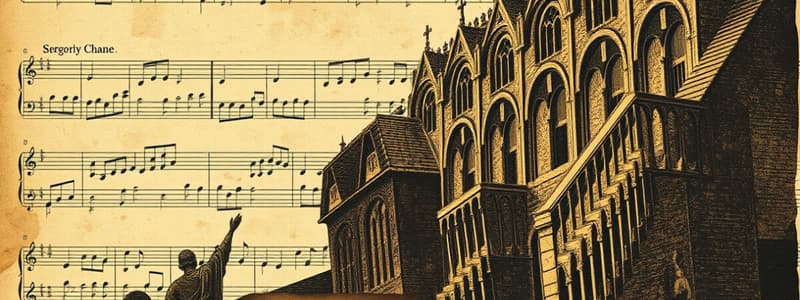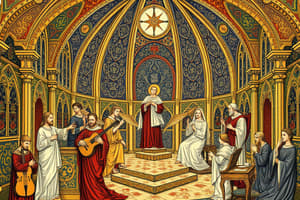Podcast
Questions and Answers
Which music form was the official music of the Roman Catholic Church during the Medieval period?
Which music form was the official music of the Roman Catholic Church during the Medieval period?
- Troubadour Music
- Secular Music
- Gregorian Chant (correct)
- Minstrels
What musical notation system originated from Gregorian Chant?
What musical notation system originated from Gregorian Chant?
- Tablature
- Graphic Notation
- Neumes (correct)
- Staff Notation
Which of the following characteristics describes Gregorian Chant?
Which of the following characteristics describes Gregorian Chant?
- Monophonic and free meter (correct)
- Harmonized and syncopated
- Polyphonic and structured
- Multi-voiced and rhythmic
What themes did Troubadour music predominantly focus on?
What themes did Troubadour music predominantly focus on?
Who was known as one of the oldest secular composers during the Medieval period?
Who was known as one of the oldest secular composers during the Medieval period?
Which group was known as versatile entertainers in medieval courts, performing various acts?
Which group was known as versatile entertainers in medieval courts, performing various acts?
Minnesingers were specifically known for singing about which subject?
Minnesingers were specifically known for singing about which subject?
Where did Troubadours originate and write their music?
Where did Troubadours originate and write their music?
Flashcards are hidden until you start studying
Study Notes
The Medieval Period
- Known as the Middle Ages or “Dark Ages," initiated by the fall of the Roman Empire.
- The Catholic Church emerged as the dominant institution, shaping music with a religious focus.
Musical Forms of the Medieval Period
- Music was categorized into sacred and secular forms.
- Sacred music included Gregorian Chant.
- Secular music featured Troubadour music.
Gregorian Chant
- Official music of the Roman Catholic Church for centuries.
- Also referred to as Plainsong or Plainchant, it is monophonic.
- Named after Pope Gregory I, who endorsed it.
- Utilizes Neumes, an early form of musical notation.
Characteristics of Gregorian Chants
- Monophonic texture, meaning a single melodic line.
- Free meter; rhythm is flexible rather than rigid.
- Based on Latin liturgy, central to Church services.
- Notation relies on Neume notation.
Troubadour Music
- Soundtrack of medieval life, covering various secular themes.
- Commonly focused on chivalry and courtly love.
- Engagement of Troubadours and their performances contributed to social commentary.
Minstrels and Jongleurs
- Minstrels were itinerant entertainers who shared news and gossip.
- Jongleurs (or jongleuses) were multi-talented performers who sang, danced, juggled, and showcased animal acts.
Troubadours and Trouveres
- Troubadours from Southern France were traveling poet-musicians.
- Trouveres in Northern France shared similar roles.
- Both flourished in various European courts, engaging audiences with their art.
Minnesingers
- A specific group of singers dedicated to themes of courtly love.
Characteristics of Troubadour Music
- Generally monophonic, occasionally accompanied by instruments.
- Focused on themes of chivalry and courtly love, portraying societal ideals.
- Originated in France and predominantly written in the French language.
Famous Composer of the Medieval Period
- Adam de la Halle (1237 – 1288) was a notable French-born trouvére.
- Known as Adam le Bossu (Adam the Hunchback); he was among the earliest secular composers.
Famous Works of Adam de la Halle
- "Le Jeu de Robin et de Marion," a recognized work showcasing medieval theatrical music.
- "La Chanson du roi de Sicile," another significant contribution to the chanson genre.
Studying That Suits You
Use AI to generate personalized quizzes and flashcards to suit your learning preferences.




